
Endless Space 2 Review
Endless Space 2 is a very charming game. From its myriad of handcrafted faction-specific quests to the significant selection of creatively developed races, Amplitude’s latest strategy game oozes charm out of its every pore. A 4X sci-fi title, Endless Space 2 takes place in the same universe as previous Amplitude games; a galaxy that was once colonised by a heavily advanced race called the Endless, whom since vanished. The game is a sequel of both Endless Legends and Endless Space 1, and they're all connected via a shared setting and gameplay.
Like its predecessors, Endless Space 2 is a turn-based strategy game with a big focus on Heroes and storytelling, preferring to present large and intricate cultures filled with backstory and content. From the industrialist and aggressive Soviet-inspired United Empire to the extradimensional abstractly shaped Riftborn, every single race is unique in appearance, government, and style, and each one features a distinct narrative about their origins and why they are expanding into space. The care put into every species -- both playable and non-playable -- is lovely, and the quality of the creative team is amazingly consistent throughout every facet of the title.
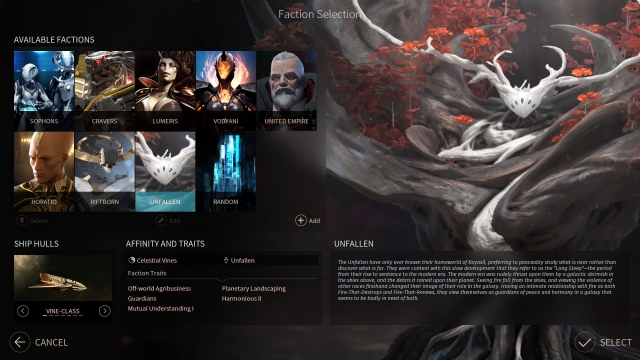
Each faction has a unique background and concept, and they all feature their own personal quests along with slightly different gameplay mechanics. The quests themselves are basically just flavour -- and very well written flavour, at that -- but ultimately all play the same; you get tasked with finding a number of anomalies, or constructing a number of improvements. The different races do get small adjustments to their playstyles, mainly thanks to the myriad of traits and internal factors that affect their starting position and overall development.
All that intricate narrative comes at a cost, and Endless Space 2 is so focused on creating a beautiful and varied presentation that it sometimes forgets it’s a game. Given how different and unique each faction is, they actually play pretty much exactly the same. Research is a severely unsatisfying universal field that gives very little substantial rewards, acting more like a number stat boost even on later tech tiers. Combat, diplomacy, and government also play out as glorified Excel sheets, offering very little palpable payout and mostly feeling like a numerical confrontation. Even building improvements offer zero feedback -- your resources increase or decrease in accordance, but every single planet looks as destitute and empty as any other.
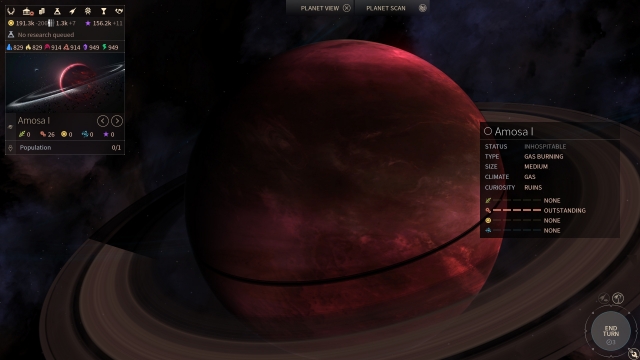
While there are different species traits and ship designs, every single race has access to the same improvements and behaves in exactly the same way, to the point it contradicts their entire premise. I understand the appeal that Infinite Supermarkets would have to the materialistic and greedy Lumeris trade empire, but I fail to see how the eternal, ethereal, and time controlling extradimensional Riftborn would care for such a thing. Makes sense for the decadent Soviet-style United Empire to have protests outside a bureaucratic government building regarding what the politically correct term for an alien is, but for the huge, ancient, Ent-like trees that make up the Unfallen race, that barely even have a building, let alone bureaucracy? Not so much.
That cookie-cutter approach extends even as far as side quests narratives goes, with events shared between races regardless if it fits their character or physiology. Similarly, political discord and groups are the same across every single species: they all have political groups such as industrialists and pacifists, and inexplicably, they all have elections -- even the dictatorial governments. Given the strangeness of some factions, that gap gets even harder to explain: the race made up of clones of its sole dictator shouldn’t be subject to the same internal political strife that the multicultured Human empire is.
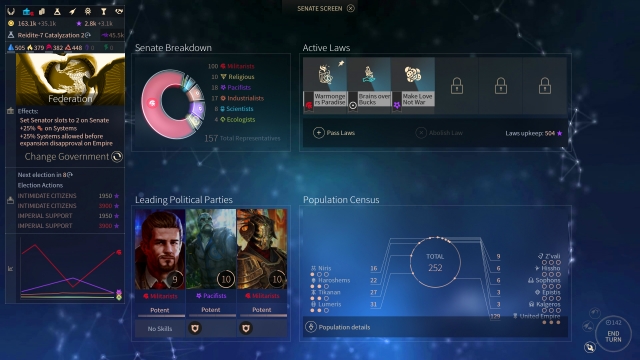
Gameplay mechanics are also shared, to the point of disappointment. While race specific ships look absolutely amazing, featuring great animations and handcrafted visuals, they all share the same weapons, sound effects, and behaviour; a fleet or army made of longevous gigantic trees fights in the exact same way that a swarm of short lived ravenous cyborg insects. Inexplicably, even individual hero ships all look exactly the same right down to the paint job, regardless of which species or society they come from, creating a severe discordance between the unique cultures in the title and their non-existing correlation in-game.
The blatant lack of difference between specific races does not manifest itself solely on visuals, but on gameplay mechanics. For example, Riftborns are naturally able to manipulate time, yet the only use of that clearly game-breaking ability comes from their ability to create singularities: small area of effect bubbles in a single controlled star system that increases or delays the time it takes to build something -- and which expire after a few turns. It is underwhelming and thoroughly disappointing.
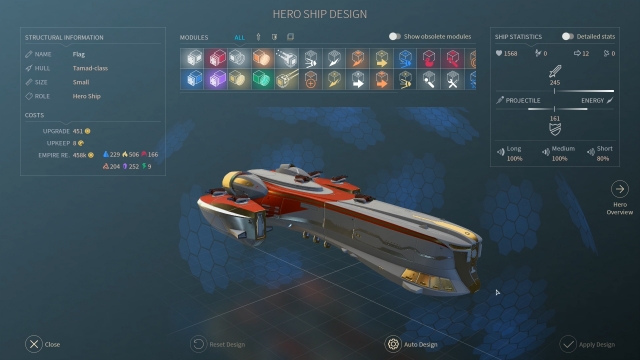
The most significant variance comes from the way some empires expand. Most cultures expand their civilisation via colony ships and transports, placing outposts in habitable planets for several turns until the settlement becomes self-sufficient. The tree-like Unfallen, however, colonises nearby territory via expanding vines and literal interstellar roots, sending a small Vine ship that spends a dozen turns literally entwining a neighbouring star system. The lore explanation for that is non existent, but it is a remarkably interesting alternative.
The gameplay itself is quite enjoyable, if shallow. It retains the intrinsic relaxed vibe of a turn-based strategy game, but significantly streamlined -- the lack of several options makes Endless Space 2 feel remarkably casual. Battles can be either autoresolved or watched in 3D, but not fought directly. You send your ships to a location, pick one out of three “tactics” they should follow, and hit go. While minor engagements are boring, fleets with a large number of ships are a joy to watch, with several ships firing at each other and auto-camera smartly cutting between the action to show you who’s hitting who. It eventually gets boring and repetitive, as ships look different but all act the same, with machine gun projectiles and lasers shooting against ovaloid blue shields that encompass crafts, but it is fun for a while.

Empire management is complicated a bit by the addition of numbered strategic resources such as titanium and , in addition to the currency-like Dust and the usual yields of food, production, and research. Most systems don’t exceed more than four planets, making their management easy, but Amplitude went slightly overboard with their streamlining: systems -- regardless of how many planets there are -- only have one production queue, and each building and improvement applies system wide. It’s a bit odd, from a logical standpoint, that colonising a planet in your home system 200 turns after the game started will give it all the improvements of the eons old capital. It furthers intensifies the separation between game and lore.
Ironically, it’s approach to star systems gives it significantly less freedom than found on other titles such as Sid Meier’s Civilization; while on other games you may go anywhere and explore your surroundings, Endless Space 2’s collected gravity wells and weirdly placed systems means there is a remarkable amount of empty dead space between areas of interest. Weirdly, the galaxy itself feels small and empty even when the settings are adjusted before starting a game, and the procedural generation comes off as remarkably artificial. It is a pretty galaxy, but it lacks the je-no-se-quai that makes outer space so endearing.
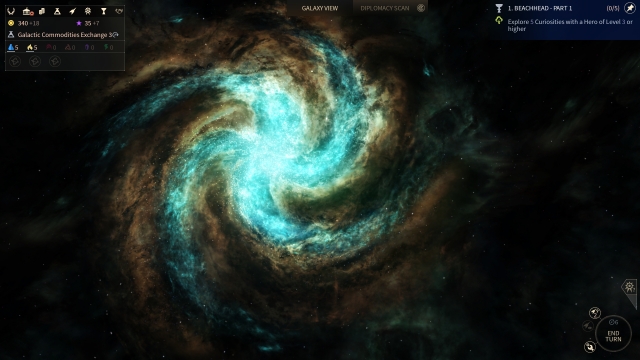
Paradoxical character of the void aside, Endless Space 2 is an amazingly beautiful game -- but not in the common sense. The graphics are good, but they are far from the main attraction; instead, the brunt of the weight is shouldered magnificently by the amazing art design and interface. The camera beautifully pans through a star system, providing an up-close shot of each planet while listing the astronomical body details in a tastefully concise manner. Upon colonising a planet, you get the rundown of its resources against the backdrop of a magnificent peak of its surface via a breathtaking animated drawing. But the real show stealer is hands-down the interface.
Endless Space 2’s UI is beautiful, and without a shadow of a doubt the most artistically functional interface I have ever seen. Zooming in on a solar system reveals rotating planets across the star in real time, and clicking on it reorganises all the planetary bodies into fixed positions for an easier display of information. System scans lead to an augmented reality screen that shows on the map the quantity and focus of resources, and as the information overlays over the contents on screen, the music lowers and gets slightly baffled. It is a masterful act of artistic feedback.

Even things like economy and politics are made more interesting thanks to the beautiful interface. Every single menu contains elements that light up or pop-out when hovered over with the mouse cursor, providing feedback for the usual boring chore of administering your interstellar empire. The diplomacy screen is quite pretty, with holographic representations of other races you encountered -- and scrambled projections of those you haven’t -- making up the contacts list, and a simple diplomatic trade screen makes it easy to offer things and see if they will be accepted, greatly streamlining intergalactic political processes.
The one problem with the interface is that it is not always clear with it’s information. The game fails to provide a number of relevant information at a glance, instead relying on a needlessly complicated sequence of clicks and actions to perform what should be simple orders. Colonies, especially, are a pain -- the game doesn’t tell you how many turns are left until it’s development is complete, forcing you to either zoom in on the planet all the way or straight up click the system. Even fleets can’t be found at a glance, requiring several clicks, and Endless Space 2 lacks an overview of any kinds that easily lists the planets and ships available on your empire.
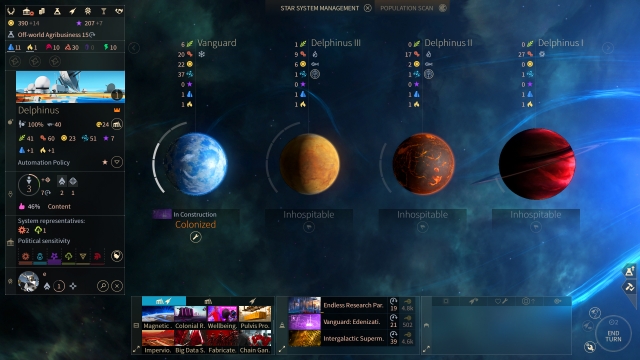
Similarly, some gameplay issues abound, especially in regards to units. The title takes a heavily abstract approach, meant to represent everything as part of a virtual simulation instead of actual little ships on screen. As a result, your crafts are blue wireframed holographical units lacking any truly distinguishable features, making it frustratingly pointless to see at a glance and without clicking which units you have stationed where. This extends into control issues, where ship selection is bad, and especially navigating hyperlanes can be troublesome -- they sometimes light up upon hovering and can be used for travelling, while other times you must right click a system directly to sent a ship to that location. Confusingly, the icon always changes to a looking glass, so you hover the Sherlockian tool over a system, right click, and the craft moves there.
Those hyperlanes are a specific beef I have with Endless Space 2. On one hand, they provide a simple, visible connection between star systems. On the other, they are ridiculously restrictive, with some locations parsecs away being separated by a lane that takes six turns to travel, while neighboring solar systems are not. Making matters worse is that a level two technology -- which can be researched less than 15 turns after the game starts -- removes the need to use hyperlanes all together (with a heavy movement penalty), rendering them utterly pointless. In order to balance it properly, the game should either severely delay the acquisition of a warp drive, or make it available immediately. As it is, it simply acts as a small hurdle that can be brushed aside with little effort, and ends up nullifying all the tactical meaning of a hyperlane while trivialising such an important piece of spacefaring technology.
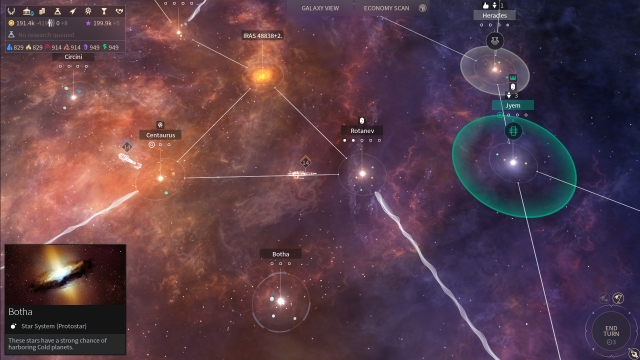
My last bit of criticism comes in the inability to fully design your own race. While I understand this was not the game’s focus, it is a definite major concern of a huge portion of the playerbase, and something I feel obliged to point out. The game does allow you to choose several details when creating your custom species, but they all ultimately fall within one of the pre-designed stereotypes. While you can choose appearance, ethics, and racial traits, they are all part of the same pre-defined visual identity -- there are no secondary portraits or variations for any species, and you are unable to mix and match different ship and portrait designs.
Weirdly, the ethos of each culture remains utterly unchanged. Unlike Stellaris, for example, where you can essentially design your own people and governments right down to their soul and core beliefs, Endless Space 2 always keeps you within its own sandbox. There is no way to make a democratic environmentalist Human faction or a stupid race of warmongering Sophons, as these cultures are respectively by default monarchic industrialists and pacifist researchers. Even the quests are the same regardless if you’re playing the vanilla faction or a custom one, severely reducing the amount of immersion you can have with your own custom race if it doesn’t fit the mold of a pre-existing one.

Technically, the title is quite good -- the graphics and sound effects are up to today’s standards, but the music is especially remarkable. Each faction gets its own composition, complete with different instrumentation and tempo, creating a vibrant and varied musical landscape that fills the senses while one goes over the exciting business of conquering the galaxy. Like Civilization and Stellaris before it, Endless Space 2 soundtrack makes sure you keep your ears on the game at all times.
A charming title, Endless Space 2 is a capable 4X sci-fi game that’s a clear improvement over its predecessor. It’s gameplay can be slightly shallow at times, and the discordance created by playstyles and the creatively handcrafted factions does hampers immersion somewhat. Those discrepancies are a direct result of Amplitude’s effort to create a heavily scripted story complete with several pre-designed races, and the developers clearly didn’t had the resources to properly expand the basic divergences between each species. Even then, Endless Space 2 is a fun game, and as one of the best turn-based space games available in the market today, it should be a serious consideration for every strategy sci-fi fun -- as long as they don’t mind playing someone else’s story.
Endless Space 2 (Reviewed on Windows)
This game is good, with a few negatives.
A charming title with a breathtakingly good interface, Endless Space 2 is a clear improvement over its predecessor.




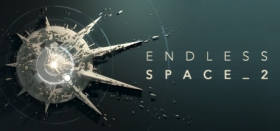







COMMENTS
GarySheppard - 11:00am, 14th June 2017
This does look like a lot of fun, another one to add to the "I'll pick this up when the backlog isn't so huge" list for me.
Meh - 07:05pm, 20th February 2018
I picked this up on steam sale and thought it was the most boring pile of crap 4X I ever played. Got it refunded instantly I guess even steam doesn't like the game. The only thing missing in its strategy is an auto turn button as you sit and watch slideshows.